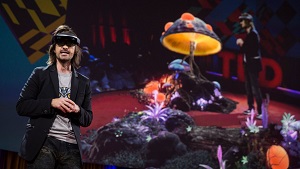Digital: Delivered: Today
 I recently traveled to Germany to discuss the future of digital transformation in the manufacturing industry at Microsoft’s 3rd annual Explained conference in Berlin. Innovation continues to thrive in the country that gave us one of the first truly disruptive technologies nearly 580 years ago: the printing press. Just think about how Johannes Gutenberg’s revolutionary invention changed the world by enabling the mass production of printed books spreading knowledge and ideas.
I recently traveled to Germany to discuss the future of digital transformation in the manufacturing industry at Microsoft’s 3rd annual Explained conference in Berlin. Innovation continues to thrive in the country that gave us one of the first truly disruptive technologies nearly 580 years ago: the printing press. Just think about how Johannes Gutenberg’s revolutionary invention changed the world by enabling the mass production of printed books spreading knowledge and ideas.
Fortunately, our passion for creating a better world is easier to achieve with today’s disruptive technologies enabling business transformation. During my session, I shared how Microsoft is partnering with Industry 4.0 leaders to build their digital enterprises of tomorrow. The new systems of intelligence are empowering manufacturers to deliver significant results. It’s creating new business models, forming new ecosystems and remaking industries. Staying competitive in this era means evolving to become an enterprise software and data company.
Achieving more with the “new” Microsoft
Digital business transformation is happening everywhere, including at Microsoft. Our CEO Satya Nadella redefined our company’s role and mission: Microsoft will empower every person and every organization on the planet to achieve more. We have been executing on this mission over the past few years by transitioning from a strong culture of technology excellence, to one that obsesses over our customers. This means first understanding our customers’ desired outcomes, and then building a technology platform to deliver.
Fast forward to today. Microsoft now offers the most business-ready platform—the most open, comprehensive, secure, and enterprise-friendly from data/privacy policies to compliance and security. We went from competing with everyone in the IT industry to being “the home of the IT industry.” Today, you can have all major Linux distributions and all major databases, as well as Open Source and Open Stack on our platform. We are embracing iOS and Android—in addition to Windows—in terms of enabling mobility of experiences and executability of new insights coming from systems of intelligence.
We are leading with the technologies of tomorrow such as artificial intelligence, bot frameworks and cognitive services. We are delivering broad new capabilities such as predictive maintenance, asset management, remote monitoring, and genomics—among many others—as first-party offerings from Microsoft. We are always thinking about the success our customers can have with technology—building tools so that others can innovate, build their own technology, and create solutions that make things happen.
 Transforming the aerospace industry with Rolls-Royce
Transforming the aerospace industry with Rolls-Royce
Longtime customer, Rolls-Royce is a great example of a company harnessing the power of digital technology. In less than a year, our partnership progressed from establishing a shared vision to announcing the first success of our digital alliance and then celebrating our first customer. Singapore Airlines is now using Rolls-Royce’s new digital platform, which brings together best-in-class solutions from Microsoft and our partners for aerospace engineering and cloud computing, including advanced analytics and the IoT, to fundamentally change engine-related operations and services.
Today, Rolls-Royce can monitor 13,000 jet engines at any given time; identifying every single plane, with their departure and arrival airports. From the engine needing a wash or the pilot not sticking to the ideal route, to knowing when a part needs to be changed and ensuring its availability, Rolls-Royce is significantly reducing costs and fuel usage, improving on-time performance and maintaining the highest levels of availability. The payoff has been tremendous: Rolls-Royce is influencing 70 percent of an airline’s operating expenses—a significant jump from four percent in the past—resulting in a mind-blowing $200 million-dollar potential savings per year, per airline.
 Overhauling the automotive industry
Overhauling the automotive industry
While our digital partnership with Rolls-Royce is forever changing the aerospace industry, I am equally excited about major disruption taking place with other customers and industries. At the Consumer Electronics Show in January, we announced the Microsoft Connected Vehicle platform. Built on the Microsoft Azure cloud, this platform empowers automotive manufacturers to connect drivers to the future. Significant change is happening in this space relative to our new platform capabilities: 3D maps and autonomous driving, smart charging for electric vehicles and smart navigation, and telemetry and predictive services to prevent costly recalls and advanced driver assistance. Get ready for a completely new driving experience thanks to cognitive services, artificial intelligence as well as communication, collaboration and productivity features.
In the last two years, we announced partnerships with ABB, BMW, Daimler, Delphi, Ford, Harman, IAV, Renault-Nissan, Tata Motors, Toyota, Volvo Cars, and ZF Services, as well as mapping companies, telecommunications providers, and more. Our Daimler partnership, for example, is bringing “In Car Office” capabilities, such as automatically dialing conference calls as well as sending dictated messages and managing calendars by responding to voice commands. We’re also working to improve fuel efficiency, safety and performance in connected vehicles by partnering with Daimler Trucks North America to leverage IoT connectivity, along with telematics and predictive services.
We continue to chart the future with investments in things such as telematics, predictive services, in-car productivity, Connected Advanced Driver Assistance Systems (ADAS), and much more. Microsoft’s breadth of capabilities, commitment to the industry, and range of vision has never been stronger and we will continue to lead in the digital transformation of the automotive industry.
 Visit Microsoft at Hannover Messe: April 24-28
Visit Microsoft at Hannover Messe: April 24-28
Just two years ago, we were talking about the dawn of a new era that was happening across the manufacturing industry and beyond. It’s amazing to now see how far our industries, our economies, and our communities have come since that time.
We’ve moved from experimenting with transformative technologies such as IoT, advanced analytics, machine learning, and cloud computing to now putting those in place as part of our standard business processes—and with amazing results. We are delivering business outcomes and digital transformation for our customers.
This really came to life at last year’s Hannover Messe industrial trade event, where we showed how the new world of intelligence was emerging at that time. Our customers demonstrated real-world examples of how they were breaking new ground with Liebherr’s smart refrigerator, JTC’s smart building, Jabil’s smart factory, and Rolls-Royce’s smart jet engine.
Today, we have reached a point of true digital excellence and are looking to the next horizon of advanced technologies such as digital twins, blockchain, artificial intelligence, cognitive services, bots, and mixed reality with solutions like HoloLens. It is these technologies that will help us to reach that next wave of disruption and innovation, as we continue to accelerate the depth of our intelligence and insights, to advance our business processes to achieve top performance and cost savings, to streamline the way we imagine and produce our products and services, and finally, to delight our customers in ways never thought possible before.
I invite you to see this new era in person for yourself by meeting us at Hannover Messe 2017. Companies including Bosch Rexroth, Daimler, Ecolab, Jabil, Tetra Pak, Sandvik Coromant, Siemens, ThyssenKrupp and more will show how they are delivering excellence in manufacturing today.
 Seeing is believing: The technology vision for tomorrow
Seeing is believing: The technology vision for tomorrow
Until then, I encourage you to watch this Ted Talk with Microsoft’s Alex Kipman for a vision of where technology is taking us. Kipman shares his thoughts for the next phase of technology evolution: how a 2D world can experience 3D holographic content, enhancing the way we experience life beyond our ordinary range of perceptions. While what you will watch seems nearly impossible today, believe it or not, it happened more than a year ago. The technology is actually possible—today.
If Kipman’s future vision seems difficult to grasp, just think back to Gutenberg and other inventors who dared to dream big and create a new reality for the world. Imagine what they would think of all the transformation taking place. People being in the same room without being in the same room? Doctors doing surgery from different locations? Engineers working on the same design from remote locations? These and other onetime “dreams” are now a reality. Tomorrow is indeed today.
Allow yourself to dream of where breakthrough technology can take your organization and stakeholders, then hold on tight—by partnering with Microsoft, you are already on your way. We are engaging with education institutions, policy makers, chief learning officers, enterprises and more to prepare the workforce for a digital environment with new capabilities and skills that boost productivity and competitiveness, foster innovation and drive growth.
We, at Microsoft, are working on a better world for all of us.
I look forward to meeting you at Hannover Messe to show you how!
Twitter: @Caglayan_Arkan




